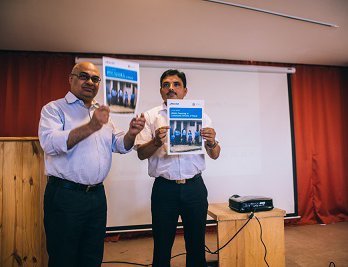
For Ganga Khadka,15, a resident of Nepaltar, Balaju, three days of every month are painful. Grade 10 student at a nearby public school, Ganga often goes absent from classes due to the lack of adequate toilets in the school.
“I remain absent from the school during the menstrual days. I have a routine life and fixed time for eating and I am treated as untouchable," said Khadka.
The situation in far western Nepal is very different as women are sent to cowsheds for four days as they can cannot touch their family members in that period.
As Nepalese women have been facing difficulties and trauma, Nepal joined to celebrate the first Menstrual Hygiene Day. It remains to be seen how it can bring changes in the life of the Nepalese women.
Each day 219000 Nepalese women between the age of 15-49 are menstruating. However, the hygienic situation in the schools is pathetic. Globally, each day more than 800 million women between the ages of 15 and 49 are menstruating. Yet menstruation remains a taboo subject. Despite menstruation being a natural process that is part of nearly every girl’s and woman’s life, it is still treated as a taboo in countless cultures and societies across the globe.
Although the priority of Nepal government is to provide access to water and sanitation to all by 2017, there are still huge resource gaps. Overwhelming numbers of public schools do not have separate toilets for female students.
Prepared by Department of Education with the financial support from WaterAid Nepal, WASH Financing in Community Schools of Nepal reveals a grim picture of sanitation facilities in the public schools.
According to the study report, the total number of separate toilets for girls available in community schools is 20,095 against the required 66,801. To reach national standards, it is necessary to build more than 46,700 toilets within 2017 A.D. It means more than 11,000 girl friendly toilets have to be built each year.
Marking the first Menstrual Hygiene Day in Kathmandu, Department of Education and WaterAid jointly launched a study report on ‘WASH Financing in Community Schools of Nepal’ amid a public event organized at the participation of key stakeholders from government, civil society, development partners, INGOs and other representatives of different government . The study analyzed the current situation of WASH facilities in community schools, especially girl’s access to school sanitation and menstrual hygiene facilities and estimated resources required in meeting universal access to school sanitation within the standards set by Department of Education.
Jointly unveiled by WaterAid’s country representative Ashutosh Tiwari and Jhapper Vishokarma of Department of Education, the report said the average cost required for the construction for girl-friendly toilets in a school is about NRs.613,000, which refers 26.6 billion additional investment are required to meet one toilet per 50 students.
This means, 6.6 billion rupees are required per annum to meet the target of 1:50 ratio by 2017. However, the government could make only Rs. 250,000 per girl friendly toilet. In Fiscal Year 2013, the Department of Education allocated NRs. 500 million to construct the girl-friendly toilets in community schools.
Students are facing a lot of problems for the sustainable and hygienic use of toilets due to the lack of water supply, wash basins and soaps in schools. There is a need for software interventions in schools for raising and fulfilling sanitation demand in community schools.
“You might wonder why a water and sanitation INGO is talking about menstrual hygiene. It’s because we are trying to make the important point that for women’s empowerment, we should start with something like menstrual hygiene. Reliable access to adequate safe water and sanitation is one critical element which gives women a sense of freedom, and keeps her healthy during menstruation,” said Ashutosh Tiwari, WaterAid’s Country Representative for Nepal. “By talking about periods, we can help normalize this natural process and help girls and women live healthier and more dignified lives.”
Why the 28th of May?
May is the 5th month of the year, representing 5 days, or the average number of days (between 2-7) a woman or girl spends menstruating each month. And, 28 represent the average number of days in a menstrual cycle.
In Nepal, MHM day was celebrated by organizing different programs which were coordinated by Nepal Fertility Care Center (NFCC) with support from WaterAid Nepal, USAID and UNFPA in partnership with key government departments (FHD, DOE, NFEC, DWC and NHEICC) and other different stakeholders including INGOs, NGOs and civil societies. The theme was “Let’s start the conversation about Menstruation.”
According to a study report, there are over 29,000 community schools in Nepal. Among them, only 69% of the schools have separate toilets for girls. Though many schools have separate toilets for girls, most of them do not meet the standards set by Department of Education (DoE).
Department of Education has set the standard norms of one toilet for 50 students but in reality, on an average, one toilet serves 166 girl students in Nepal. Manang is only one district of Nepal where 100% of school have separate toilets for girl students and the toilet student ratio is 1:15. In contrast, only 10% schools have separate toilet for girls, in case of Jajarkot district where the toilet student ratio is quite abnormal i.e. 1:1038.
The total number of separate toilets for girls available in community schools is 20,095 against the required 66,801. To reach national standards, it is necessary to build more than 46,700 toilets within 2017 A.D. It means more than 11,000 girl friendly toilets have to be build each year.
The average cost required for the construction for girl-friendly toilet in a school is about NRs.613,000, which refers 26.6 billion additional investment are required to meet one toilet per 50 students. This means, 6.6 billion rupees required per annum to meet the target of 1:50 ratio by 2017.However, the government could make only Rs. 250,000 per girl friendly toilet. In Fiscal Year 2013, the Department of Education allocated NRs. 500 million to construct the girl-friendly toilets in community schools
Students are facing a lot of problems for the sustainable and hygienic use of toilets due to the lack of water supply, WASH basins and soaps in schools. There is a need for software interventions in schools for raising and fulfilling sanitation demand in community schools.
“Sanitation and water access in school premises enhance school enrolment, reduce girls absenteeism and dropout rates and improve girl students' education performance,” said Dr. Lava Dev Awasthi, director General of Department of Education.
It is too easy to say these things than get them done. In a country where the development expenditure is gradually declining at the cost of concurrent expenditure, putting such a huge amount of money is virtually impossible. “There is the need to have a huge investment to build toilets in public schools and raise awareness at the community level about biological part of menstrual hygience,” said Vishokarma. "As a lot of female students prefer to remain in house during periods, it has affected the quality of education of girl child.”
- SENIOR CITIZEN: Nowhere To Go
- May 09, 2014
- PRISM: Poverty Reduction
- Apr 19, 2014
- Women's Rights: Continuing Fight
- Mar 09, 2014
- WATER AND SANITATION: Fluid Crisis
- Feb 15, 2014
- WATER & SANITATION: Clean Call
- Jan 11, 2014

















